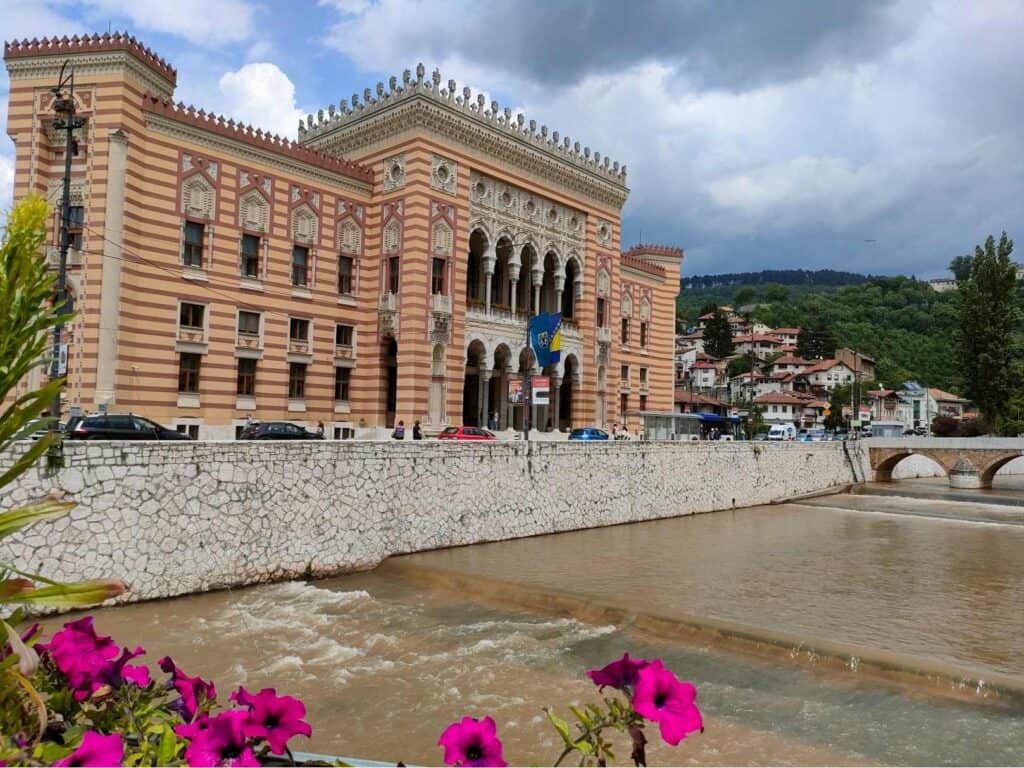This article may contain affiliate / compensated links. For full information, please see our disclaimer here.
Sarajevo is at the crossroads of East and West, influenced by Rome, Venice, the Ottoman, and the Austro-Hungarian Empire, where mosques, Catholic and Orthodox Church, and even Synagogues stand close to each other. Diversity has always been a main characteristic of Sarajevo. Despite 90% of the buildings being of socialist-style, with the old district Baščaršija, it is a city that catches your heart immediately. This is a complete travel guide, including an itinerary for one day, 2 days, and 3 days, depending on how much time you have in Sarajevo.
- Is Sarajevo worth visiting?
- How many days should you spend in Sarajevo?
- How to get around in Sarajevo?
- Where to sleep in Sarajevo?
- Sarajevo one day, 2 days, 3 days itinerary
- What are the best things to visit in Sarajevo?
- Best viewpoints of Sarajevo
- Best museums in Sarajevo
- Best local tours in Sarajevo
- Best day trips from Sarajevo
- Višegrad, Andrićgrad, Šargan Train, Drvengrad Tour
- Other posts about Bosnia and Herzegovina
Is Sarajevo worth visiting?
Definitely! Sarajevo is a unique melting pot of cultures that shows the image of a lively, bustling city. Sarajevo is where you can enjoy the excellent Bosnian cuisine, café culture, and nightlife while getting an understanding of one of the most devastating wars in history because Sarajevo’s history is inseparable from the events of the 1990s. The buildings in the suburbs still bear the signs of the war. When you stroll around the streets of Sarajevo, imagine that the city didn’t have a single intact window and had cut down most of its trees to heat and cook with. Obviously, it is a complicated city.
It is a city where you feel like returning multiple times, and you could spend several days immersed in its multicultural atmosphere, enjoy the view of the city from the surrounding hills and make day trips to discover places outside Sarajevo.
Bosnia Herzegovina travel guide and itinerary (4, days, 5 days and one week)
How many days should you spend in Sarajevo?
You should spend at least 2 or 3 days in Sarajevo to have enough time to visit some museums, go on a thematic tour, check out some viewpoints, and enjoy the city’s lively atmosphere. You will find below detailed itineraries if you have one day, two days, or 3 days. Regardless of the time you have, Sarajevo is a must-see once you are in Bosnia Herzegovina.
How to get around in Sarajevo?
Most of the public transport vehicles are donations by foreign countries as they were completely destroyed in the war. Sarajevo has a tram along the river to Baščaršija, but it is under renovation (June 2023) and is currently being replaced by buses.
How to get from the bus/train station to Sarajevo center if you are backpacking in Bosnia and Herzegovina?
You can either walk (it takes 40 minutes to go to Pigeon Square (Sebilj) or take a bus from the National Museum (one ticket costs 1.4 KM~0.7EUR). Taxis have a flat price of 20 KM (~10EUR) from the bus or railway station to downtown.
Where to sleep in Sarajevo?
Low-budget:
Apartman White River is a private apartment in a big family house behind the Jajce barrack. It is a simple nice place with a view of the city. The Sebilj is a 10 minutes walk from here. If you don’t mind walking steeply up, this is a great choice to stay near downtown.
Old Town Studio: This can be a good choice if you prefer staying as close as possible to Baščaršija. It is a modern apartment, only a few minutes from Pigeon Square on the ground floor of an older residential building.
Beautiful View of Sarajevo Center: If you want to enjoy a superb panorama right from your apartment for an affordable price, this is a good option. It is 1.8 km from Baščaršija.
WAR HOSTEL: a unique place to stay, not for comfort but because it is a kind of war museum run by a family who lived there during the war. It is for those who want to educate themselves and really get an idea of what it was like living under the war. The modern amenities (electricity, wifi, hot water, etc.) is not missing, but it is not a party hostel. Check out this extraordinary place, which also organizes tours.
Mid-range hotels
Studio Apartments Siesta: the location can’t be better, only one minute from Sebilj
Casa ARTEE Free Parking: with the perfect location, a very modern studio apartment with private parking is an excellent choice for a still affordable price.
Miaap Apartments: centrally located neat and stylish apartment
Hotel Holiday: Why not stay in the iconic Holiday Inn hotel, built for the Winter Olympic Games 1984. During the war, it was the base of international media teams along the Sniper Alley and part of all war themes of local guides tours.
High-end hotels
Hotel Europe is one of the most famous hotels in Sarajevo, with a 130-year tradition located in the heart of Sarajevo, the popular Baščaršija.
Swissotel Sarajevo: this modern hotel with contemporary design rooms is a 10-minute drive from the Latin bride and 5 minutes from the airport. The cuisine is a mix of European and Middle Easter. The hotel also has wellness facilities.
Sarajevo one day, 2 days, 3 days itinerary
One day in Sarajevo:
– Taste traditional pitta dishes of burek, zeljanica (spinach and cheese), sirnica (homemade cheese), and krompiruša (with potato) for breakfast
– Take part in the local guided tour Times of Misfortune tour that includes the Olympic sites, the best viewpoint at the Yellow Fortress, the Tunnel of Hope
– Discover Baščaršija (Gazi Husrev-bey mosque, madrasa, Bezistan, Sebilj, Morića Han, the coppersmith street, City Hall, Emperor’s Mosque)
– Walk along Ferhadija to see the Sacred Heart Catholic Church and the New Orthodox Church nearby
– Finish your day in a local restaurant trying the most famous Bosnian food, Ƈevapi.
Day 2 in Sarajevo
– Take the cable car to Trebevič mountain for the great view and walk to the Olympic bobsleigh track
– Take part in the free walking tour Neno and friends: War Scars and Modern Times
– Visit the Galerija Museum about Srebrenica or the Olympic Museum
– Try Bosnian Cuisine (dolma, Sogan Dolma) for dinner and relax in a bar smoking shisha
Day 3 in Sarajevo
Take a full-day tour to one of these places:
– Travnik, Jajce and Pliva waterfalls
– Hiking tour to Lukomir village
– Srebrenica/Potočari memorial
– Take the half-day food and crafts tour, and you can use this day to immerse in Sarajevo’s other districts: Vratnik and Bistrik districts, having a coffee on the 35th floor of the Avaz Twist Tower.
What are the best things to visit in Sarajevo?
The liveliest part of Sarajevo is the Baščaršija, which comes from the name “market,” as it was the trading center of the city. The streets have also been named after the crafts practiced there for centuries. This area is where most tourists stay and the center of social life with plenty of cafés, restaurants, and shops selling oriental-style souvenirs, local sweets, and handicrafts. Most buildings, including the mosques, were built during the Ottoman period.
The heart of Baščaršija is the popularly known “Pigeon Square” (due to the number of pigeons favoring the place) with Sebilj, the wooden fountain. Such water sources were placed throughout the Ottoman Empire for people to get fresh water and close to mosques for ritual purification. Being the central meeting point for locals, it is busy day and night. According to some legends, you will return to Sarajevo if you drink from its water.
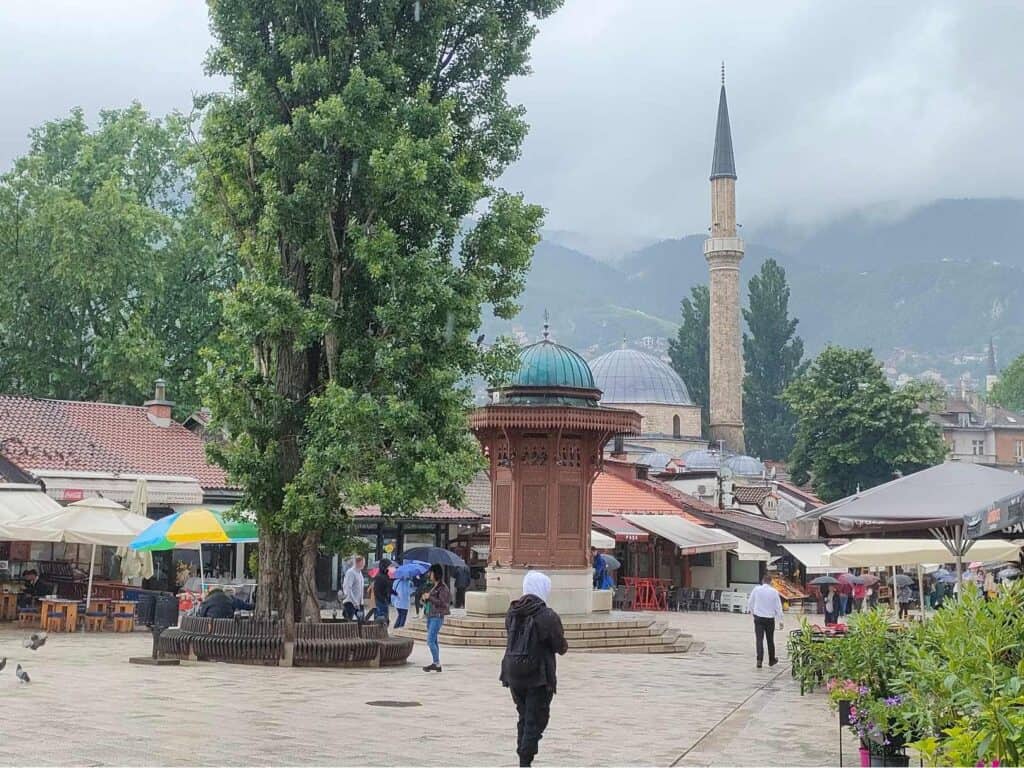
Don’t miss the small hidden square beside Sebilj called Male Daire, where locals like hanging out in one of the cafés.
Close to the square is Kazandžiluk, the famous coppersmith center with antics, copper dishes, oriental crafts, and decorations. It is a lovely street to stroll around, where you will probably find something you like for your home. The Baščaršijska džamija (marketplace mosque), one of the mosques from the Ottoman times, is also around the Sebilj.
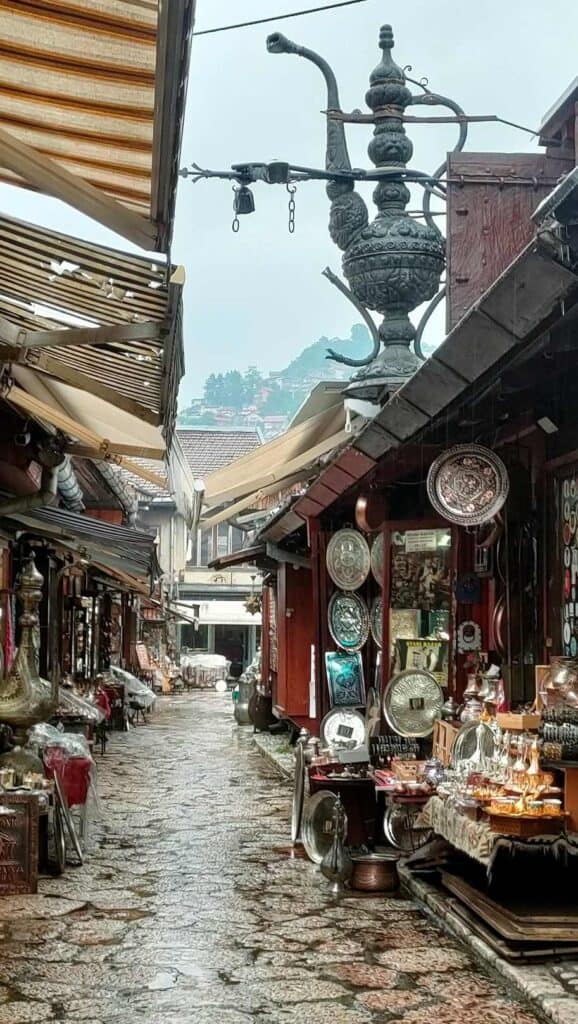
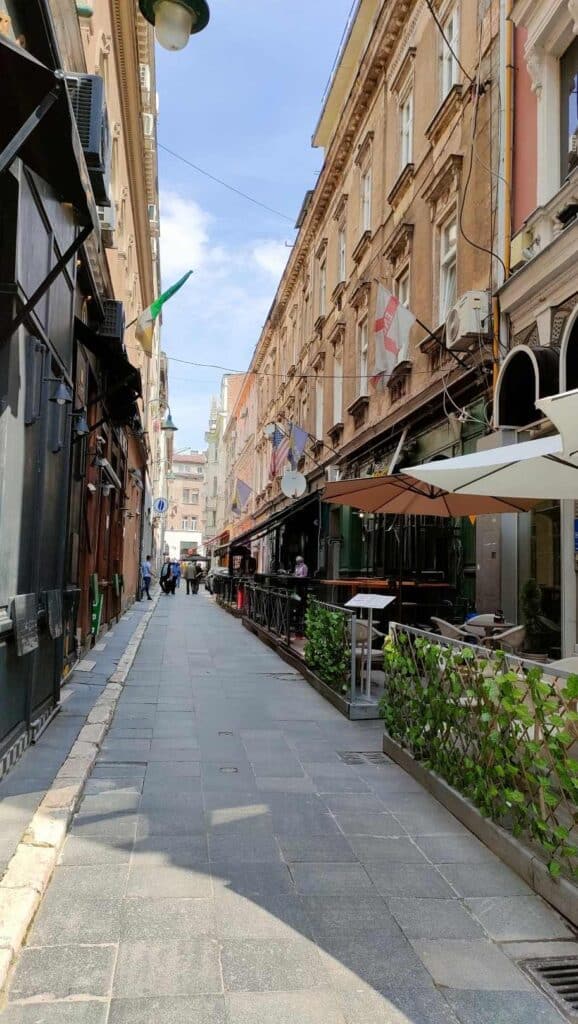
If you want to see where locals buy groceries, pass by the Markale market. However, it has a sad story, when 68 civilians died, and over 140 got injured when Bosnian Serbs bombed it in 1995. A few months after the tragedy, the Dayton peace agreement was signed, and the war ended.
The caravans carrying the precious products of the East and West were hosted in one of the inns of Sarajevo. This is where traders were accommodated, fed their horses, and exchanged goods. Morića Han from the 16th century is the most famous. Its courtyard is a popular restaurant with some shops selling carpets.
Tašlihan (meaning inn made of stone) is one of the oldest caravanserais built from the endowment of the Bosnian governor, Gazi Husrev-bey, in the 16th century at the time of the largest expansion of the city. Downstairs were storage rooms and a stable for horses while sleeping rooms occupied the upper floor. After several times being on fire, the remnants were removed, and only the wall remained.
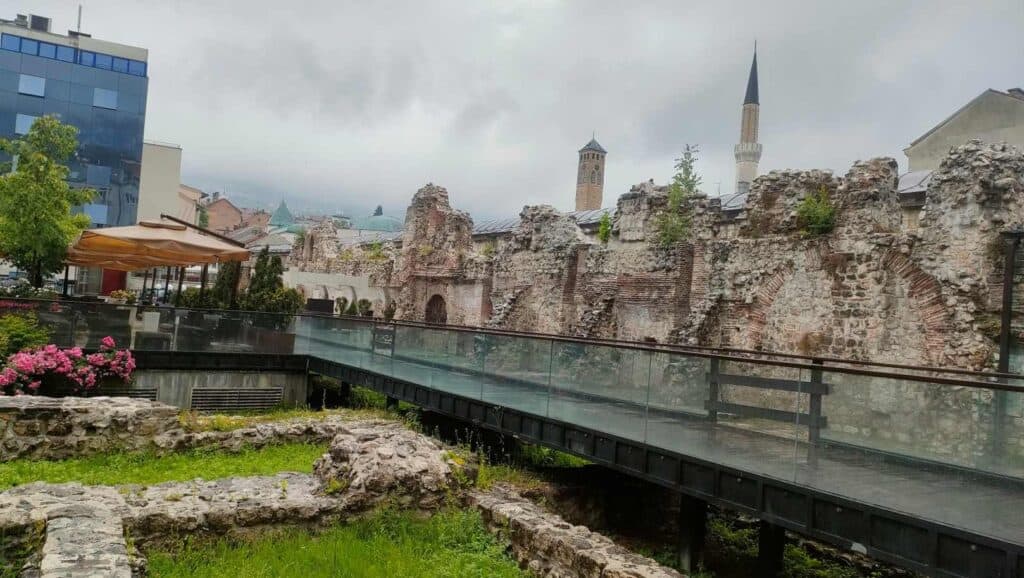
Upon its completion, a covered market called Bezistan was also built thanks to Gazi Husrev-bey, which after centuries, still functions as a covered marketplace with several shops inside. Since it was planned to serve as a grocery market, they built it below the street level to create a lower temperature. This makes the oriental department store a pleasant place to stay during hot summer days.
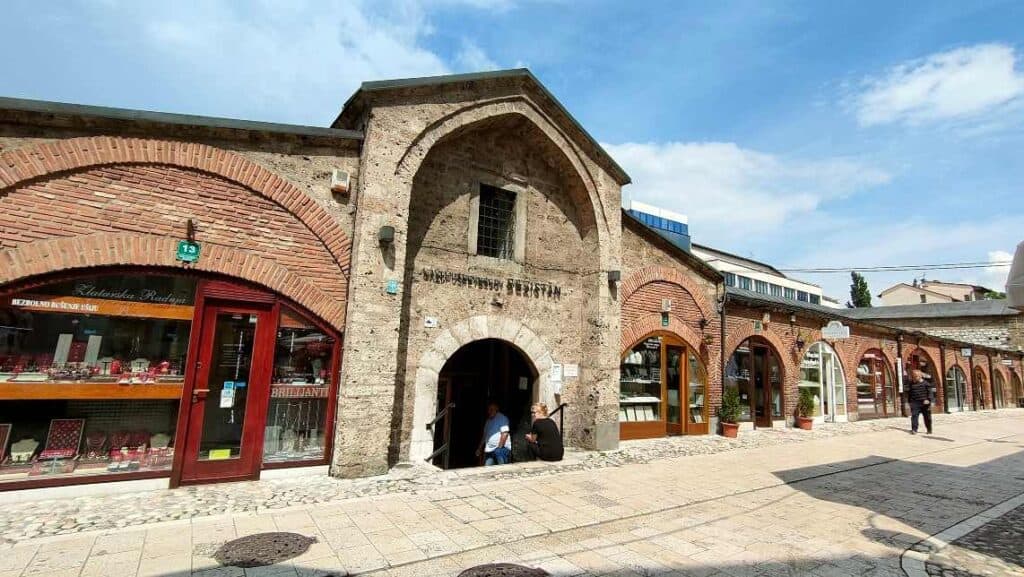
Gazi Husrev-bey mosque
The most important mosque of Baščaršija was built in 1531 and named after the Governor of Bosnia, who envisioned a city that could be compared to Damascus. Locals call it the Beg’s mosque. Somewhat hidden among the countless shops, the mosque doesn’t catch the eye as much as when it would stand alone. However, entering the courtyard, you immerse in the unique atmosphere where Muslims gather to pray and ritually wash at the central fountain. The leading architect of the Ottoman Empire, Adžem Esir Ali, a Persian from Tabriz, designed the mosque.
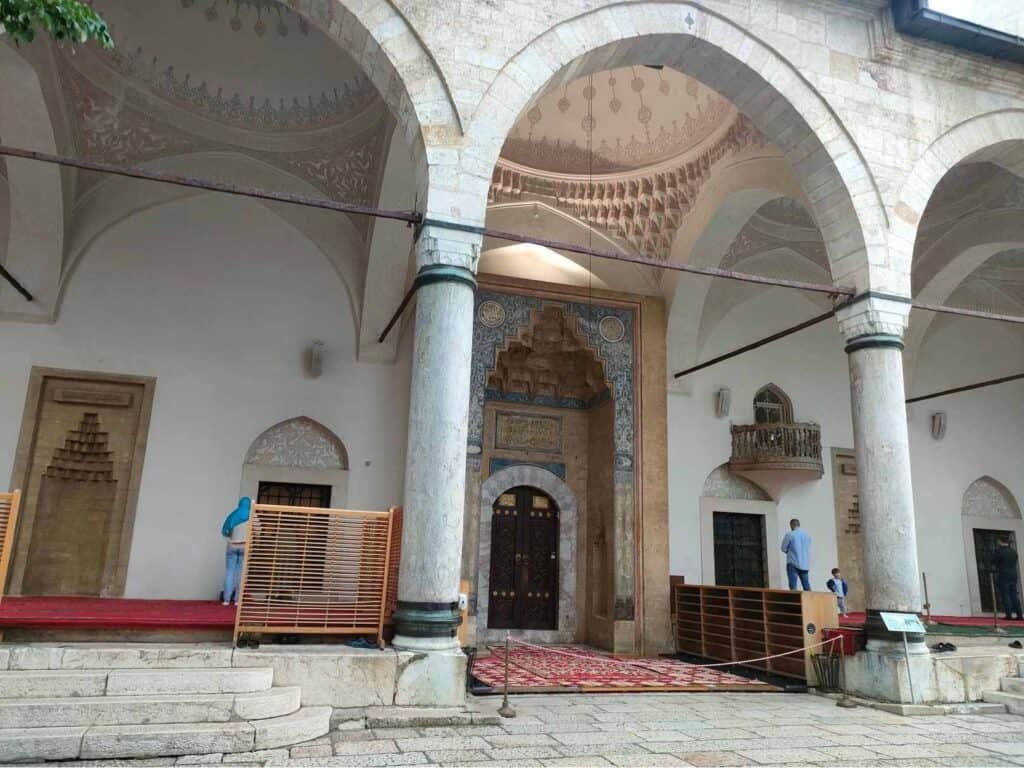
Gazi Husrev-beg dedicated his entire life to the construction and urbanization of Sarajevo, making it the most glorious period of its history that turned it into a major cultural, educational, and trading center in the 16th century. He endowed all his movable and immovable properties in the service of God.
During the siege of Sarajevo, it was hit by over a hundred mortars and artillery shells. Carpets cover the interior; some are gifts from heads of Islam countries who visited the mosque.
Tourists can enter the mosque for a visit from the side. As a woman, you should cover your body, wear a scarf and remove your shoes at the entrance to visit it.
Opening hours for tourists: 9:00-12:00, 14:30- 16:00, 17:30- 19.00
Entrance fee for only the mosque: 3 KM (~1.5 EUR)
Entrance fee: museum+mosque: 5KM
Entrance fee: museum+mosque+library: 7KM
Gazi Husrev Bey library and madrasa
The Library
It functions as a public library with a small museum, where the oldest book of Bosnia and Herzegovina is on display. It is the fourth volume of the well-known theological-mystical work, Ihya. The author is a famous Islamic mystic, a philosopher, a theologian, a jurist and a religious reformer, Abu Hamid Muhammad al-Gazali (died in 1111). Some say it is the most-read book after Quran in the Muslim world.
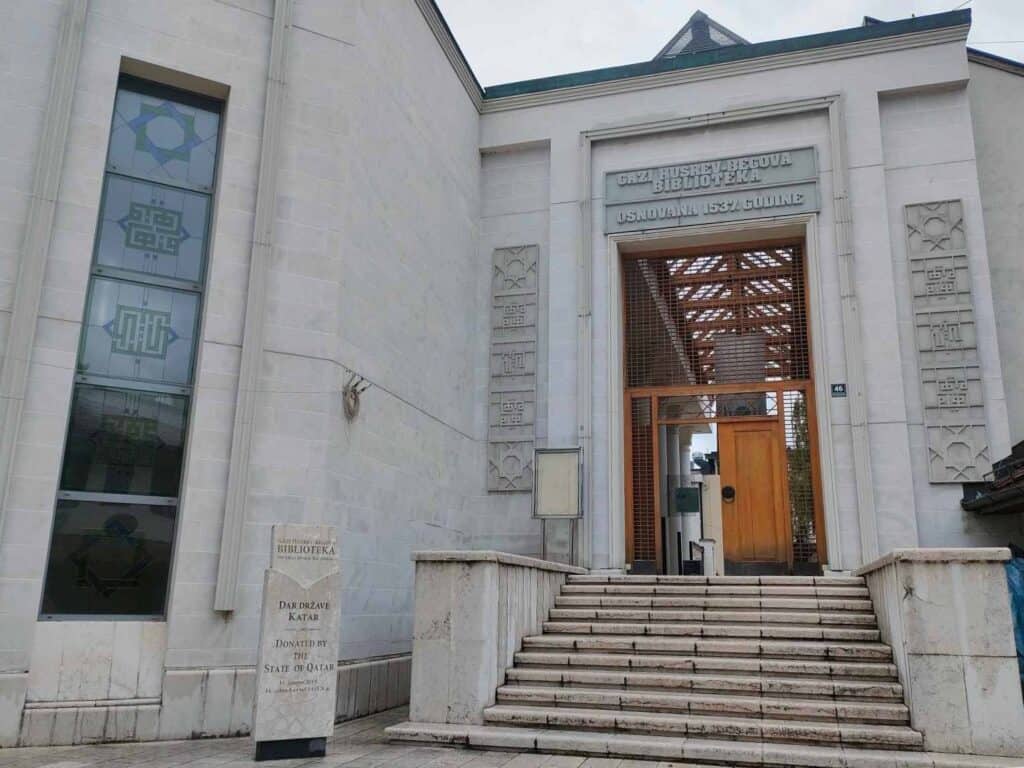
The library’ collection was seriously endangered during the war. To preserve the collection, the library started to microfilm the most important pieces. The equipment was delivered through the Sarajevo Tunnel, the only possible way to enter the city. The Gazi Husrev Beg’s library preserved its entire stock throughout the war thanks to the enormous effort of its employees who managed to relocate the manuscripts and written documents. The documentary, “The love of the books: A Sarajevo Story” is about how the employees risked their lives to save the library, thus the tradition, culture and identity of Bosnia. A short part of the movie is played in the museum, where you can see how the employees packed the volumes in banana boxes and were hastily carrying them to a safe place when being stopped in the street by people. They angrily asked how come they had bananas if others did not even have anything to eat. Then the employees opened the boxes showing there were books and nothing eatable in the banana boxes.
At the beginning of the war the library was housed in front of the Emperor’s Mosque in Sarajevo. The location of the library stock was changed several times. It contains over 100,000 volumes of manuscripts and books in Arabic, Persian, Bosnian and other languages.
The madrasa
The oldest educational facility functioning in BiH for over 470 years has been converted into a museum. The inner courtyard is surrounded by 12 rooms used by students and a lecture room, where they studied what the donator, Gazi Husrev-beg specified.
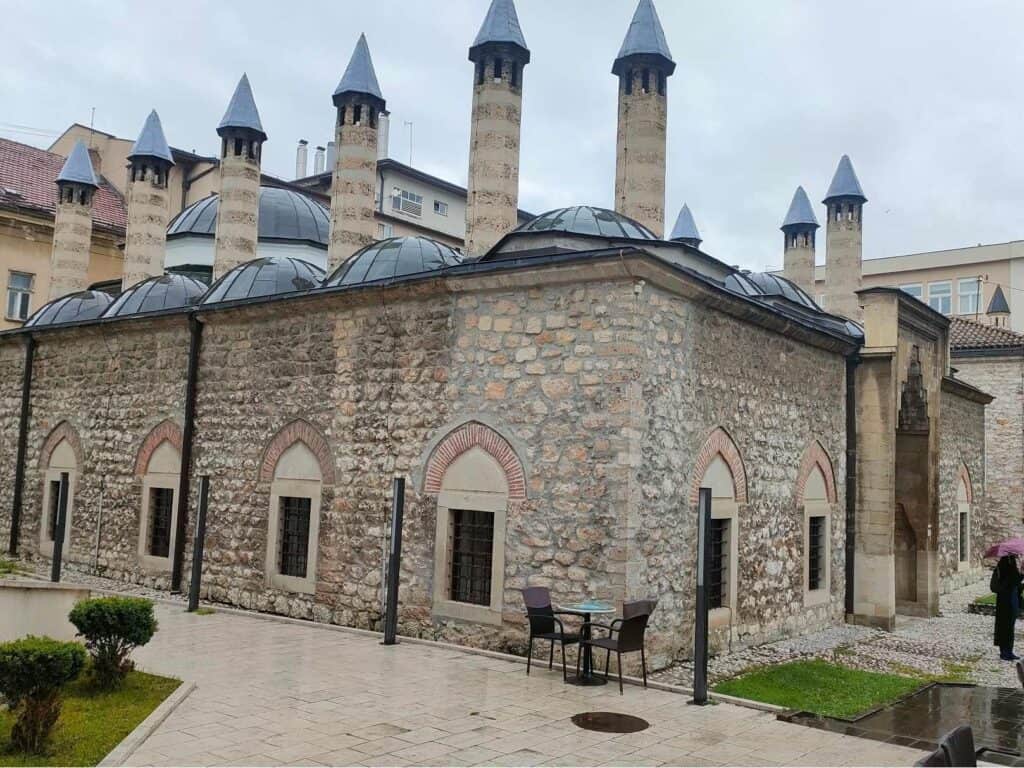
This is also the oldest medrese preserved in the whole of Bosnia and Hercegovina.
The museum highlights the life of the Beg, the establishment of his waqf (endowment) and his influence on the development of Sarajevo.
Today, next to the old medrese (the museum), there is a medrese for girls and boys attended by children from all over Bosnia and Herzegovina and abroad. 70% of the curriculum is general education and 30% religious subjects. The students learn Bosnian, Arab and English as well.
Opening hours of museum: 9:00-13:00, 13:30- 20:00
Old Orthodox Church (Church of the Holy Archangels Michael and Gabriel)
Sarajevo City Hall (Vijećnica)
It was the most representative Austro-Hungarian building, built in 1892-1894 in Moorish style. It was also the National and University Library of Bosnia and Herzegovina until 25th August 1992, when Serbian shelling destroyed it, with around 2 million books and manuscripts burnt in flames, an indescribable cultural tragedy. Some citizens try to save the books risking their lives.
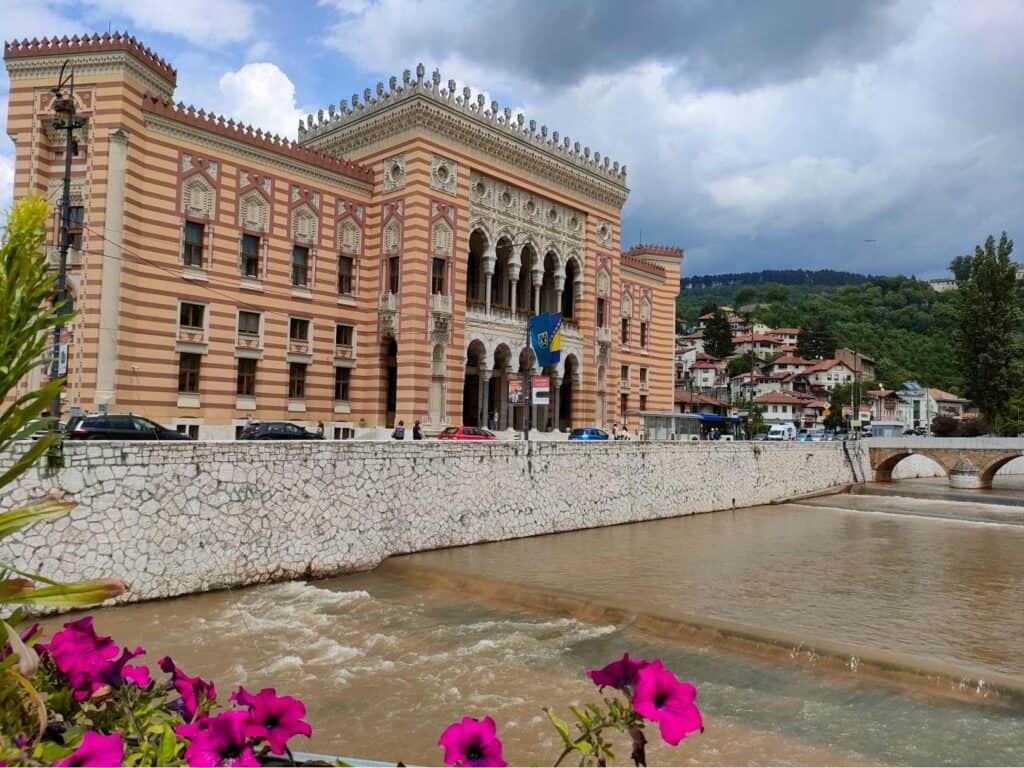
Vedran Smailović is a famous cellist in Sarajevo who regularly played amid the ruins of the National Library and other ruins under the threat of snipers. He escaped Sarajevo in 1993 and lives in Northern Ireland, but his braveness symbolizes life under the siege.
His story was written in “The Cellist of Sarajevo” book that gives a unique insight into the life of people during the war in Sarajevo.
Thanks to several donations, the building was reconstructed as much as possible and reopened in 2014. It is now the seat of the mayor of Sarajevo and the venue for exhibitions, concerts, and protocol events.
You can see the inside for an entrance fee of 10 KM.
Inat kuća (House of Spite)
Across the bridge from the City Hall, you come across this eye-catching traditional restaurant that is a city landmark. The two are connected by the Seher – Cehaja bridge, the first stone bridge in Sarajevo.
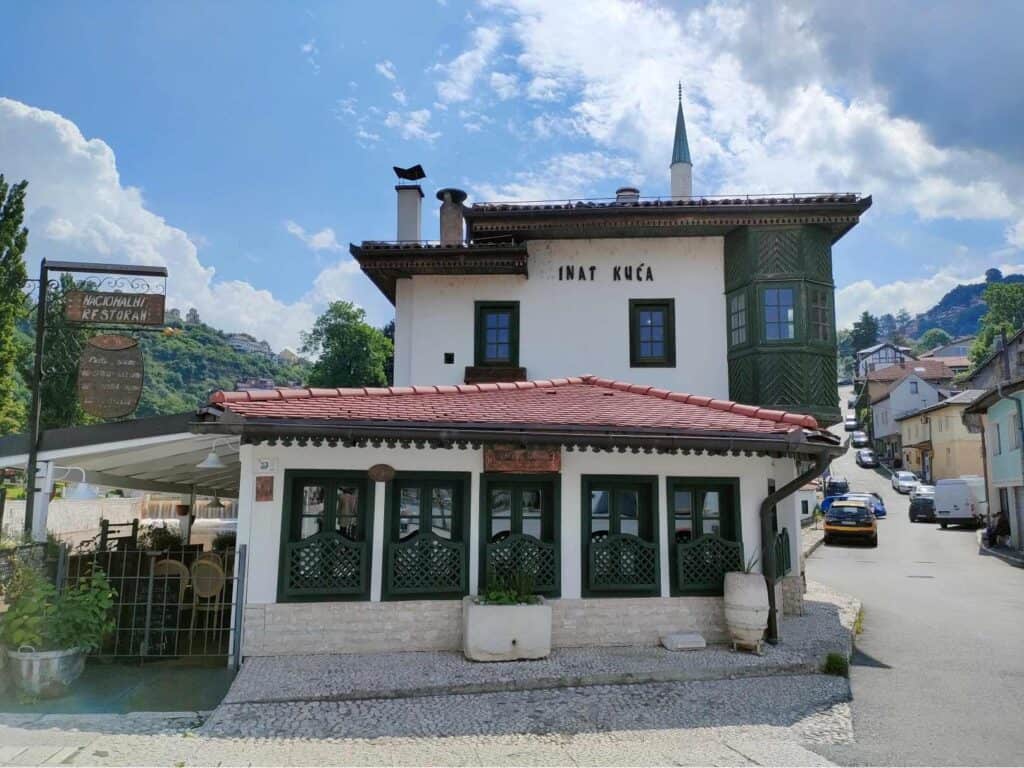
It was originally on the other side of the river where the City Hall stands. They had to demolish several buildings to construct the most prestigious building of the Austro-Hungarian Monarchy. Benderija, a native of Sarajevo, also had a house there and refused to give it up as it was also his spiritual home. After lengthy discussions, he made the Monarchy pay him bags of gold coins and move his house brick by brick to the other side of the river. This is the story of the stubbornness and spite of Benderija and Bosnians.
Sarajevo meeting culture
This is the spot where East meets West, after which even the pavement and the architecture of buildings change.
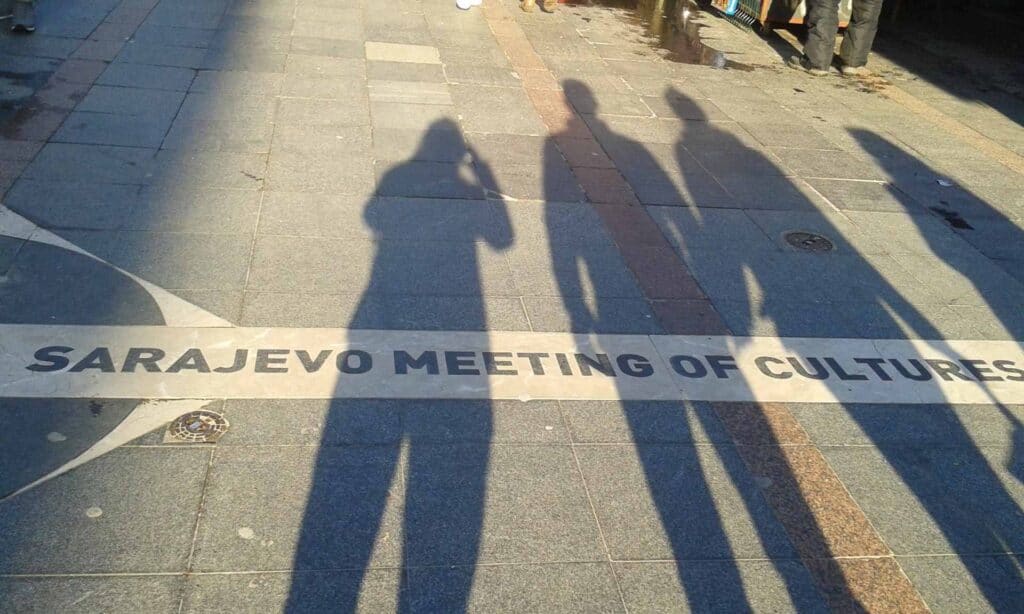
The Latin Bridge and the site of the assassination by Gavrilo Prinzip
One of the historical events in the modern history of Sarajevo and Bosnia and Herzegovina was when a young Serb nationalist, Gavrilo Princip, assassinated Archduke Franz Ferdinand, the Austro-Hungarian heir, and his wife Sofia, on 28th June 1914. In response to the event, Austria declared war on Serbia, leading to the outbreak of WWI.
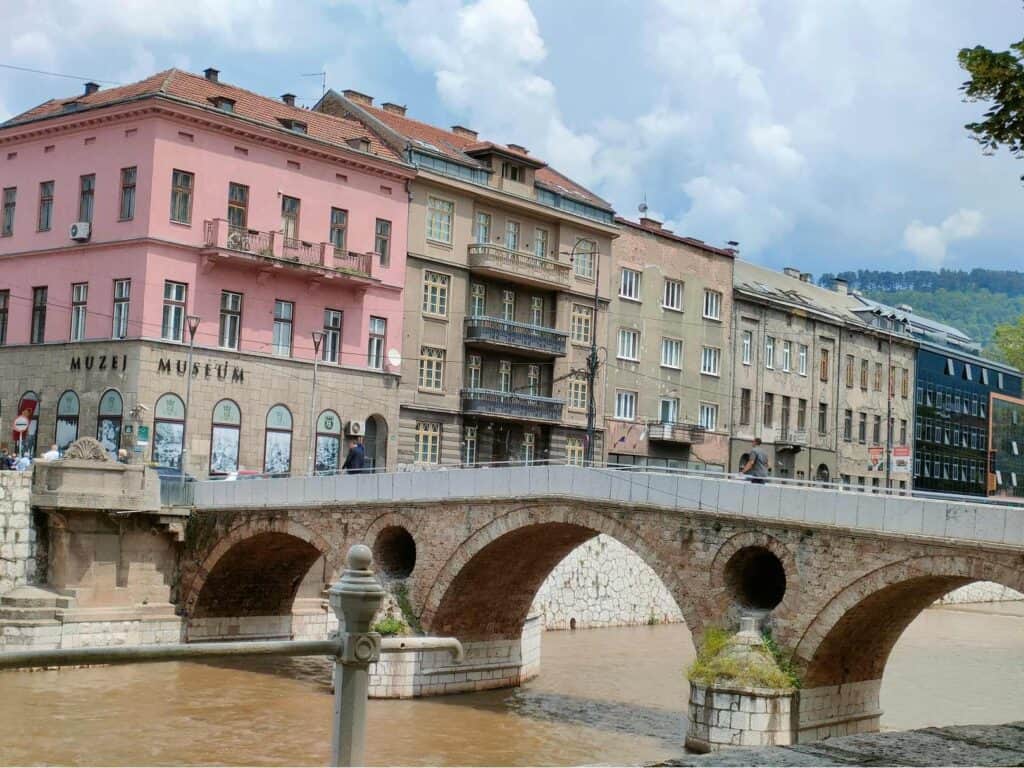
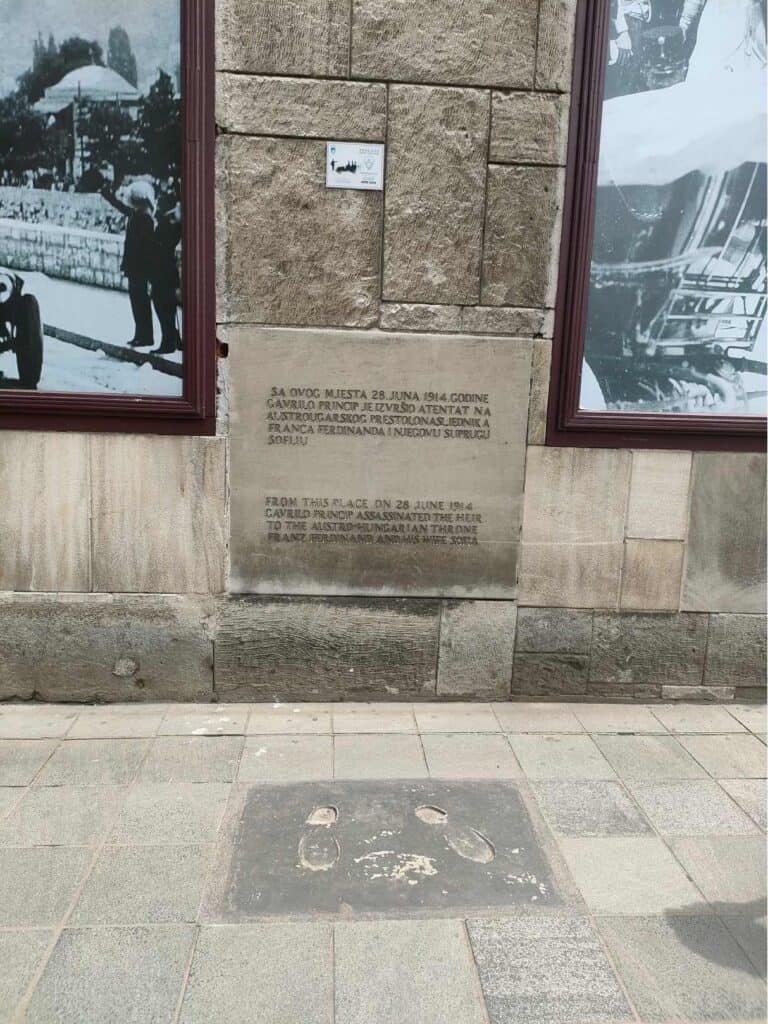
The footsteps of Gavrilo Prinzip, where he committed the attack, are marked at the foot of the most attractive bridge over the Miljacka river. In addition, you can learn more about the Austro-Hungarian period of Sarakevo’s history in the Museum of Sarajevo 1878-1918, including the circumstances of the assassination and the copy of Prinzip’s gun.
The Latin bridge was called Prinzip’s Bridge during Yugoslav times and after renamed Latin Bridge. The different ethnic groups’ interpretations of the young Serb’s act vary. He is a freedom fighter for many Serbs and pan-Yugoslavs and a terrorist for some Bosniaks).
Bistrik district of the old town (Emperor’s Mosque, Cable car)
The old town is not only Baščaršija but the Bistrik quarter on the other side of the river is also worth walking around. It is also where you can take a cable car to Trebevič. The Cable car to Mt Trebević is one of the best things to do in Sarajevo.
The Sarajevo Brewery also stands in Bistrik. The small museum may be less exciting, but you can have a beer in the pub attached to that.
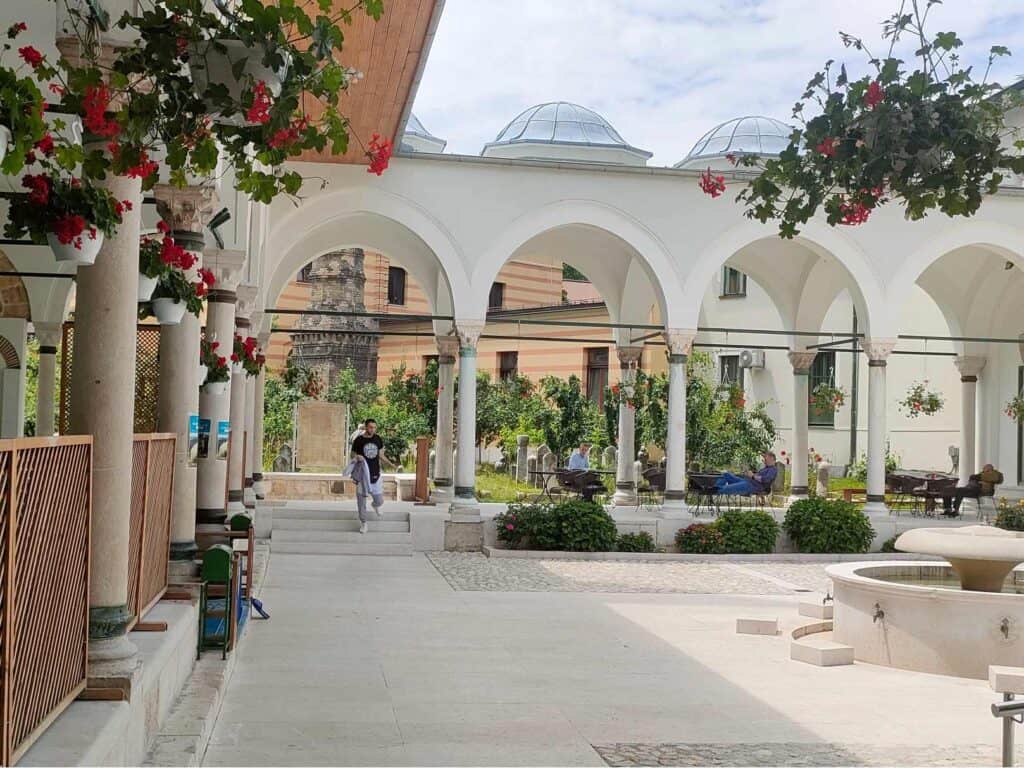
At the riverbank stands the Emperor’s mosque, the first mosque built during Ottoman rule that you can visit outside praying times. The first mosque at this place was a wooden structure, and after its reconstruction in the 16th century, it was dedicated to Suleiman the Magnificent. Next, the graveyard contains the tombs of Turkish viziers (high-ranking Ottoman officials), prominent religious and civil figures.
Vratnik district
The historic Vratnik district occupies the hillside on the other side of the Miljacka river. It has three gates; the main entry point to the old town of Vratnik is through the Višegrad gate.
The Ploča Gate houses the Alija Izetbegović Museum, dedicated to the former first president of Bosnia and Herzegovina, Alija Izetbegović.
In this district, you find two popular viewpoints of Sarajevo: the Yellow and the White Fortress.
Ferhadija
Ferhadija, the famous shopping street, stretches from Baščaršija to the Eternal Flame. The lower part from the Ottoman era is officially called Sarači, whereas the continuation built under the Austro-Hungarian period is called Ferhadija. This is the axis of downtown where most of the shopping and coffee sipping takes place in Sarajevo.
The new orthodox church Cathedral of the Nativity of the Theotokos
The new Orthodox Church was built in the 1860s and became one of the largest Serb Orthodox churches in the entire Balkan. At that time, Bosnia was still under Ottoman rule, and it was the first large-scale non-Muslim building in Sarajevo. Local conservative Muslims criticized its tower for being taller than many of the town’s mosques and wanted restrictions on non-Muslim buildings to be introduced. Its dedication ceremony was postponed by a year to 1872 because a bunch of Muslims protested against it.
Sacred Heart Catholic Cathedral
The neo-Gothic style church was completed in 1889 when the Austro-Hungarian Monarchy already gained full control of the city. The Cathedral is the most significant building along Ferhadija. The Pope gave a mass here in 1997. Young people often use the steps in front of the Cathedral as a meeting point.
At the side of the Cathedral is one of the many “Sarajevo roses,” red painted marks in the ground in the city that commemorate the most serious massacre, in which at least 3 people died during the siege. The victims were always civilians waiting in line for bread or water.
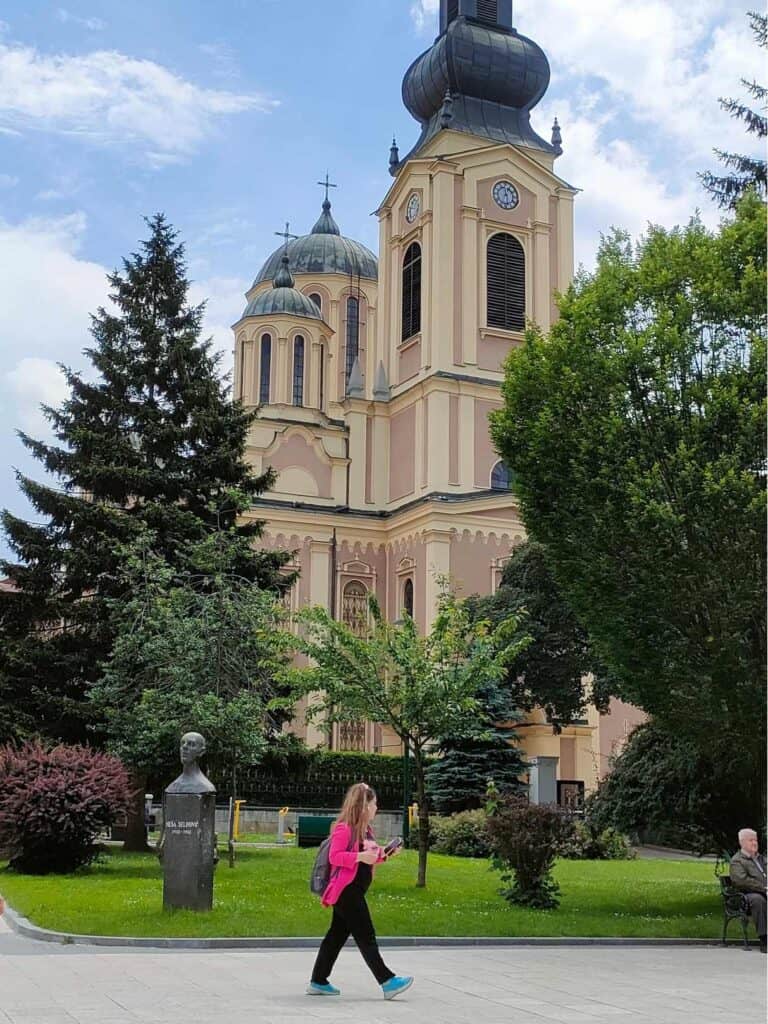
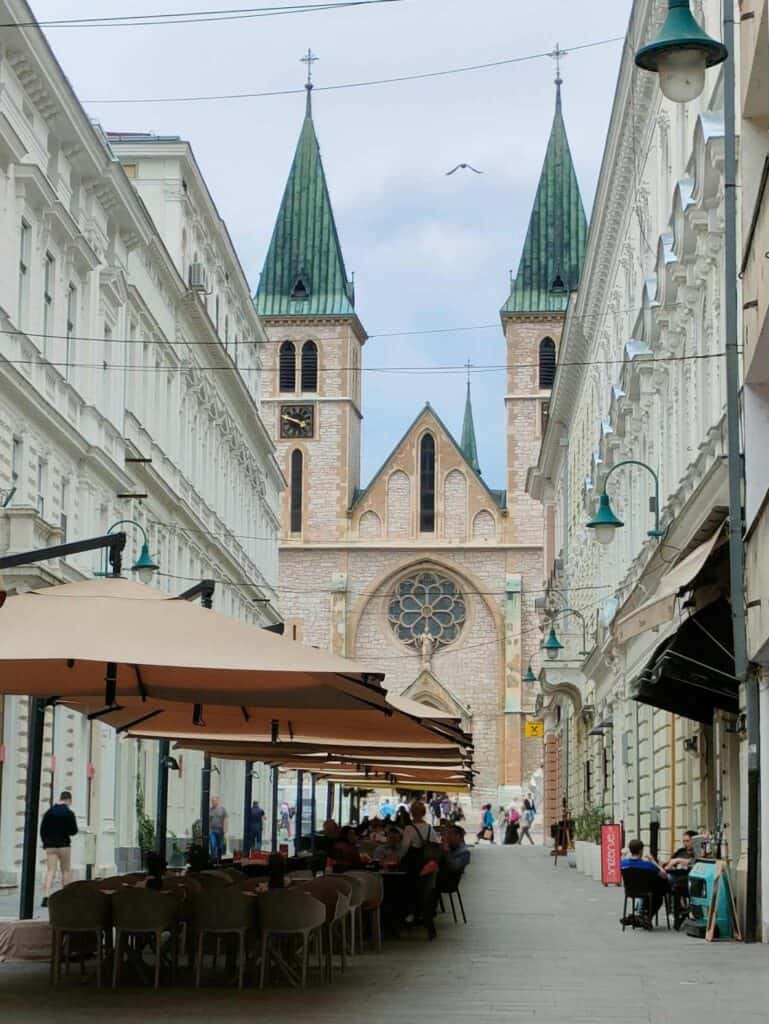
Eternal Flame
At the end of Ferhadija burns the Eternal Flame in memory of the Serbs, Croats, Muslims, and other partisans who gave their lives in liberating Sarajevo from the fascists during World War II.
“The tunnel of hope”
Other important sights of the city are linked to the war of 1992-1996 that are best visited with a local tour, where those who lived during the war will tell their stories. You can see some places alone, but it will be a different experience. Plus, some monuments, side streets, graffiti, and stories you cannot know by yourself.
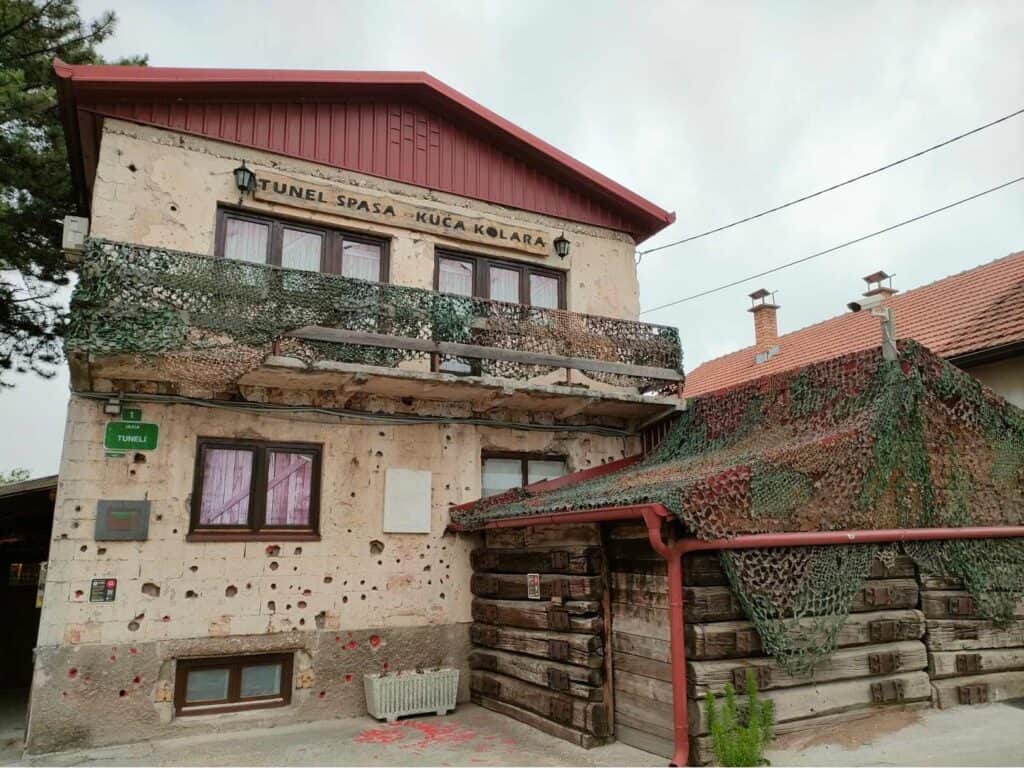
The most important reminder of the war you must include in your Sarajevo itinerary is the “tunnel of hope.”
The “tunnel of hope” built by the Bosnian Army connected Sarajevo with the only free Bosnian zone, Butmir. It connected to Croatia, from where the aid shipment was delivered to the besieged city. The entrance was through an ordinary family house under the airport to Sarajevo. Since the airport was under UN control, a neutral zone, the Serbs did not bomb that.
The 800-meter-long tunnel was built by hand for four months. It runs 1-2 meters underground, with the deepest point at 6 meters under the airport. It is not higher than 1.5-1.6 meters and 1 meter wide, so it was only possible to go through with 40kg on their backs in a bent position. The construction of the tunnel is a pure miracle. They delivered food, cigarettes, and medicine to the people stuck in the city.
Best viewpoints of Sarajevo
One of the unique things about Sarajevo is its location, surrounded by the Dinaric mountains, which over several spots to get a stunning view of the city. Sometimes, you must climb steeply up the hill unless you take a taxi.
– The yellow fortress is one of the closest viewpoints of the city, reachable within 10 minutes after passing by the Kovači Martyrs’ Memorial Cemetery
– Jajce barrack: Once you are at the Yellow Fortress, you can continue to the barracks on top of the hill. You can also check it out, but the one from the Yellow Fortress is easier to reach and requires less walking.
– White fortress: a 10-minute walk from the yellow fortress through the Višegrad gate, the entrance to the old city of Vratnik.
– Alifakovac is another easily reachable viewpoint in the eastern quarter of old Sarajevo. The graveyard is a final resting place for Muslim foreigners who died and were buried in Sarajevo. There is an excellent view of the old town from up the hill.
– Bistrik old railway station
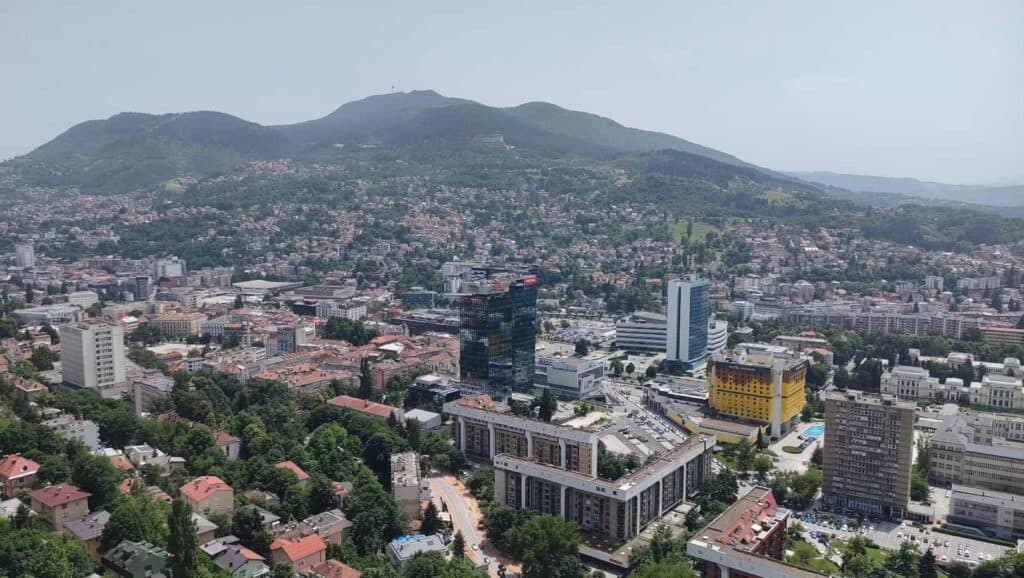
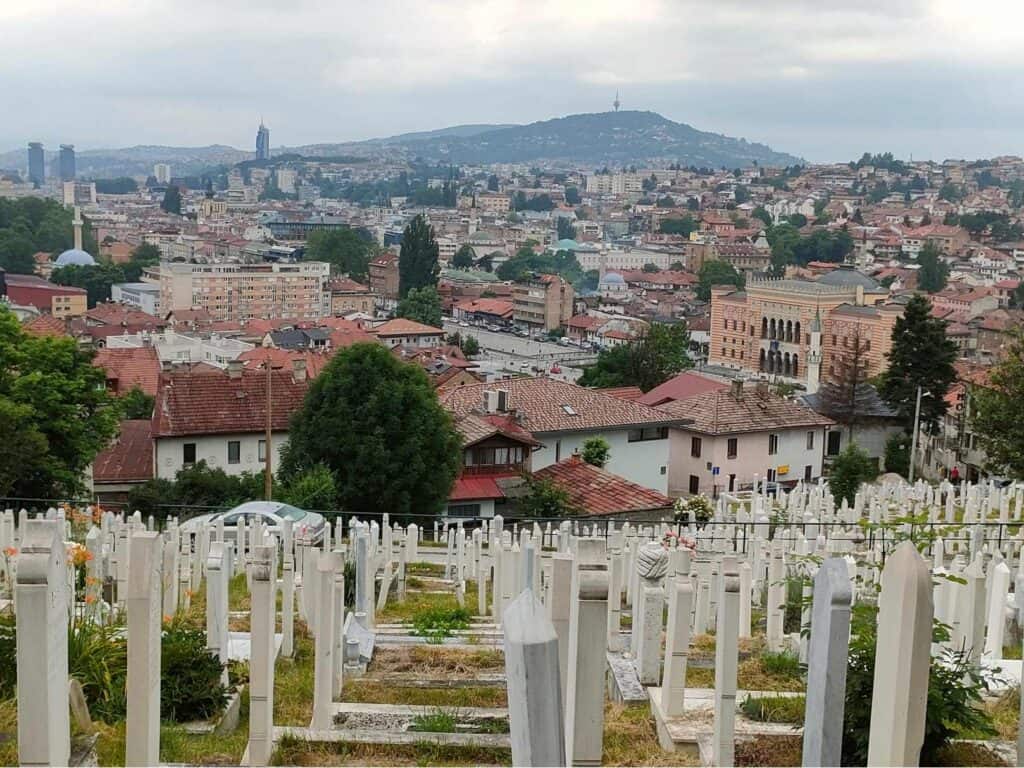
– Zmajevac: be ready for half an hour’s steep walk from Baščaršija.
– Take a cable car to Trebevič: This is one of the most excellent viewpoints of Sarajevo, where you also see the former bobsleigh from the Olympic Games. The cable car is open from 9 am to 9 pm every day except on Monday when it opens only at noon. It costs 15KM one way and 20KM return. Once you arrive, you can make 40 minute round enjoying the view and passing by the bobsleigh. You can connect it with shorter or longer hiking. Instead of the cable car, you can go up on foot or take the cable car t go up and descend on foot. From the cable car station, you can climb the Trebevič mountain (another 2 hours).
– Avaz Twist Tower: the uniquely shaped modern office building next to the main bus and railway station offers a less-known viewpoint from the 35th floor. You must pay 2KM to access the gallery and go to the lookout terrace. There is also a non-smoking café on the top if you want to stay longer absorbing the view.
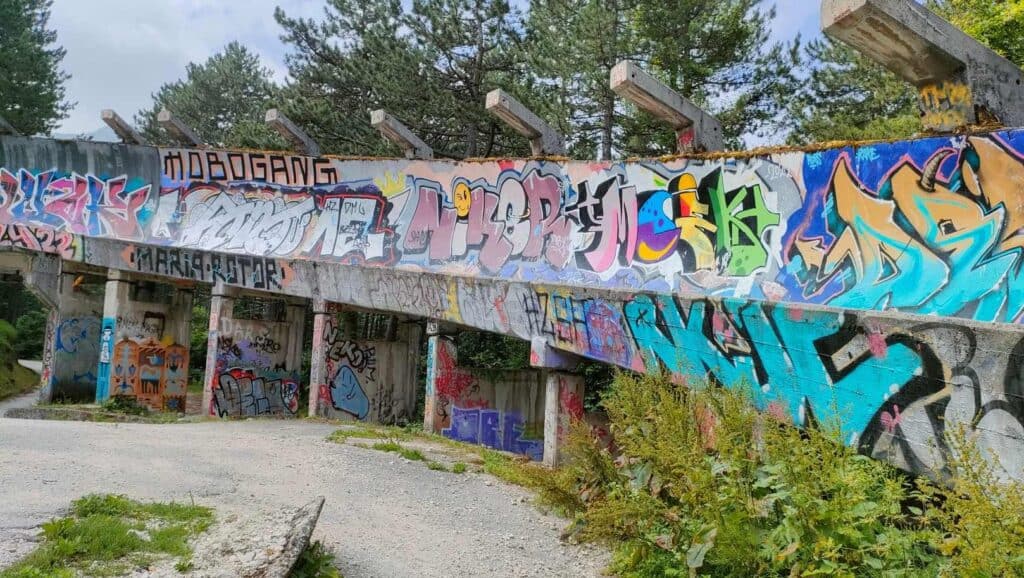
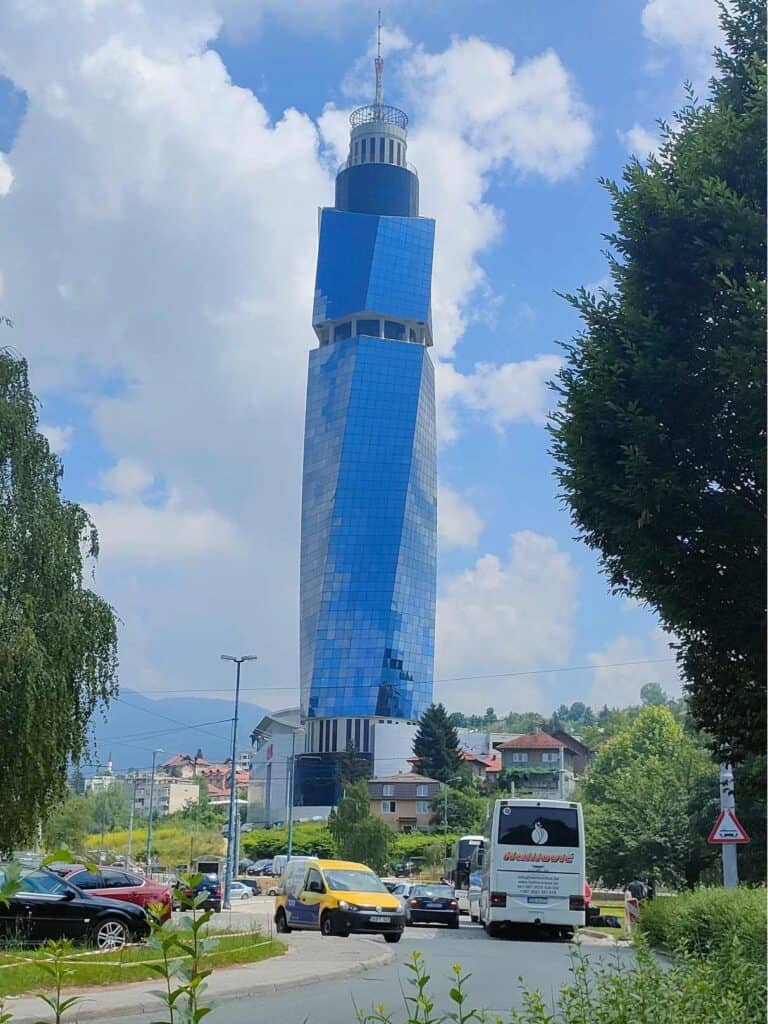
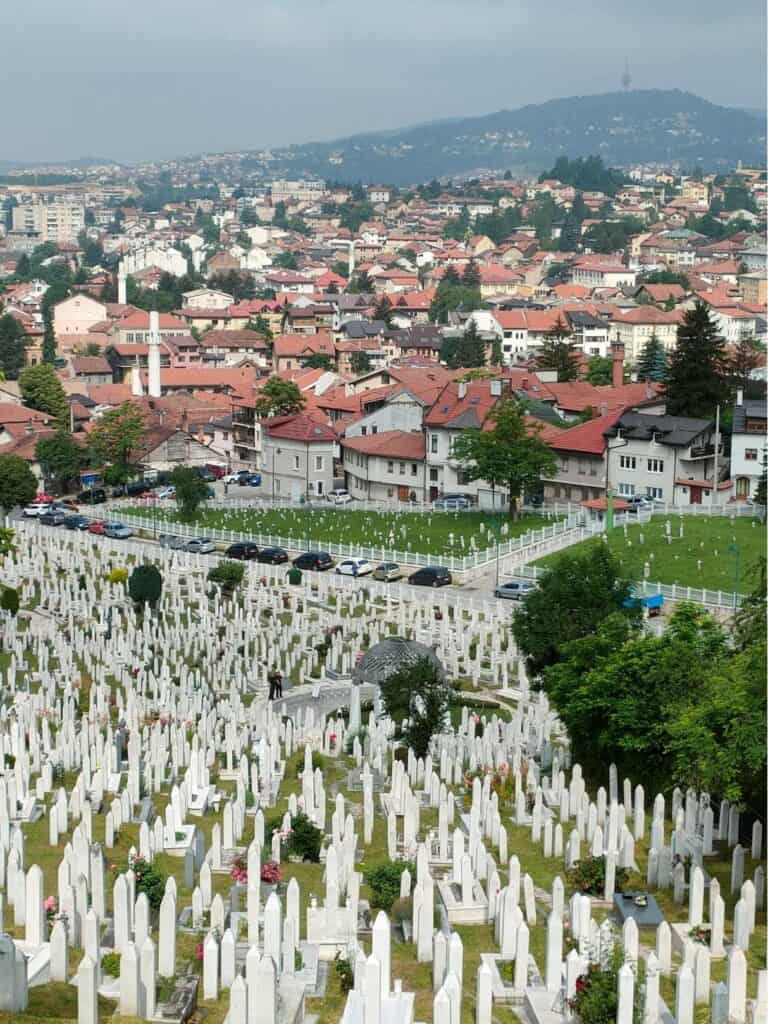
Best museums in Sarajevo
War-themed museums
Sarajevo has some interesting museums, many of them linked to the Bosnian war of the 1990s, such as the Museum of Crimes Against Humanity and Genocide 1992–1995 or the Siege of Sarajevo Museum that all worth the visit that helps you learn more about what was happening beyond the television screens and newspapers. However, if you only visit one museum, this should be the Galerija, the museum of Srebrenica. This museum brings the war as close as possible to an outsider with personal accounts, videos and photos. The central topic of the museum is Srebrenica, the cruelest massacre during the war on 11th July 1995, when over 8000 Bosniak Muslim boys and men separated from their families were killed in an officially UN-protected safe zone. This finally mobilized the international community to end the war. The identification of the dead has been going on to this day. Another part of the museum presents life in Sarajevo during the war.
Opening hours: every day, 9 am – 9 pm
Entrance fee: 12 KM (6 EUR)
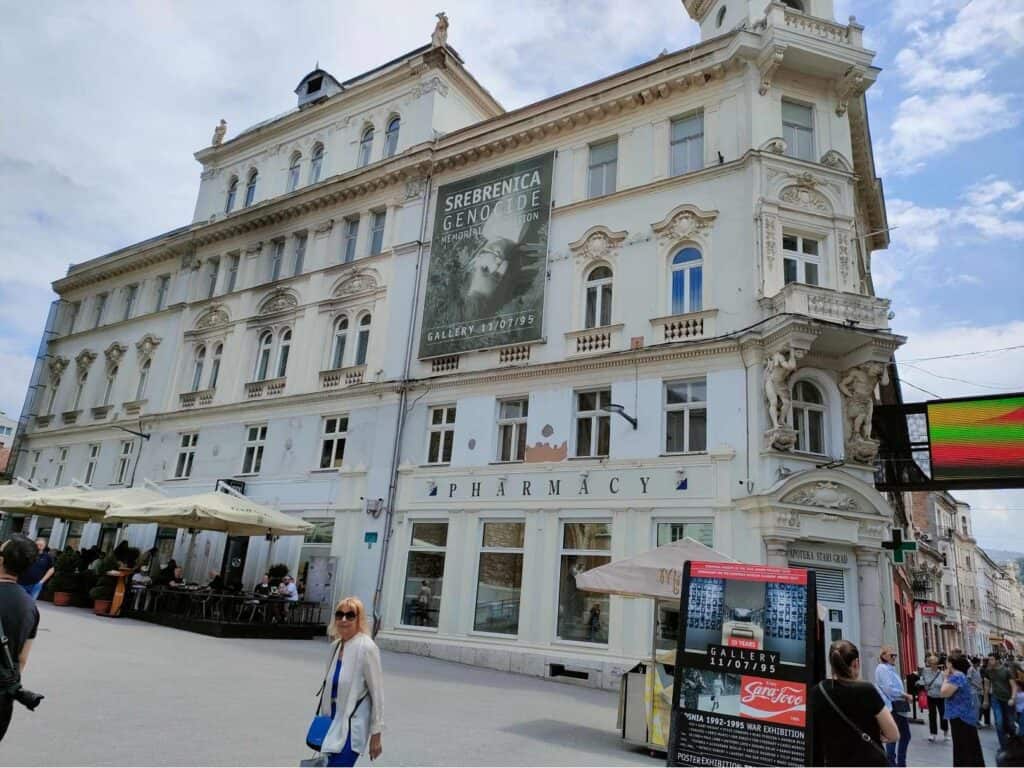
Olympic Museum
The small Olympic Museum is in an attractive building that displays videos and photos, medals, equipment, and interesting facts about the Winter Olympics 1984 that placed Yugoslavia on the international stage.
The iconic hotel built during the Olympic Games was the Holiday Inn hotel, originally designed as an Olympic hotel, a landmark of the city. Its strikingly yellow color remarkably changed the appearance of the city and soon became one of its symbols. The first guest to stay at the hotel was Juan Antonio Samaranch, the former president of the Olympic Committee. During the Bosnian war, international journalists stayed here to broadcast the war.
In addition to the extension of the Jahorina ski center, Igman and Bjelašnica were selected as new localities for alpine and Nordic skiing and ski jumping. The technology of ski jumps was so innovative that they were the standard for building ski jumps for the next decades.
Opening hours: 9 am-4 pm, closed on Monday
Entrance fee: ~6 EUR
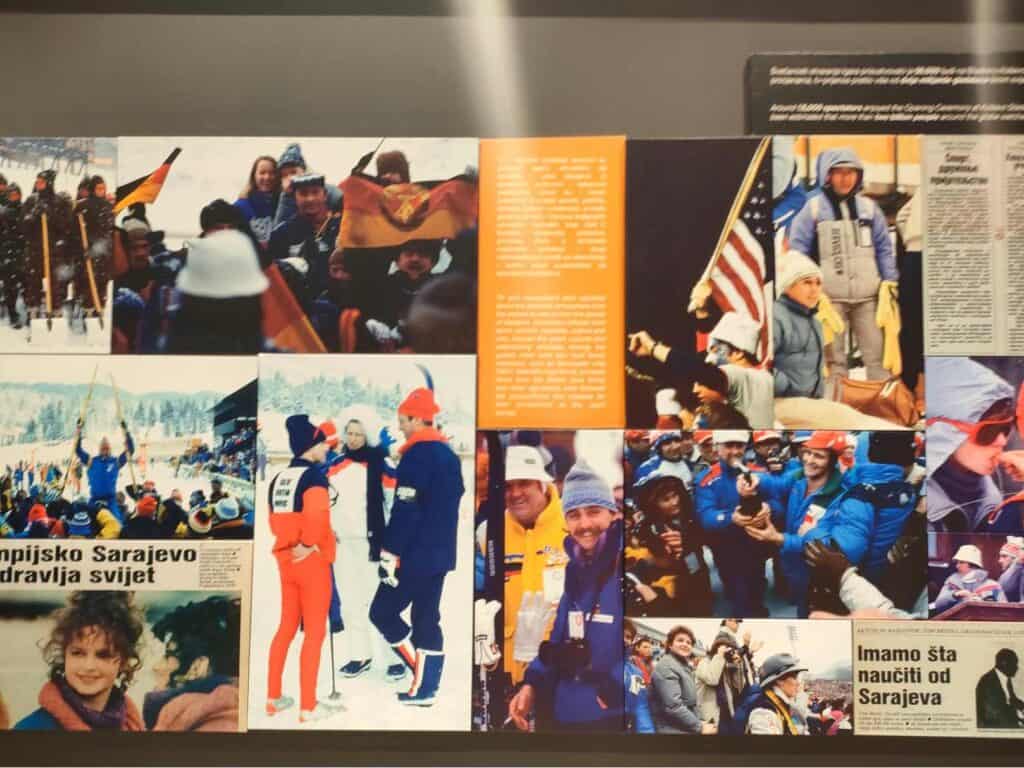
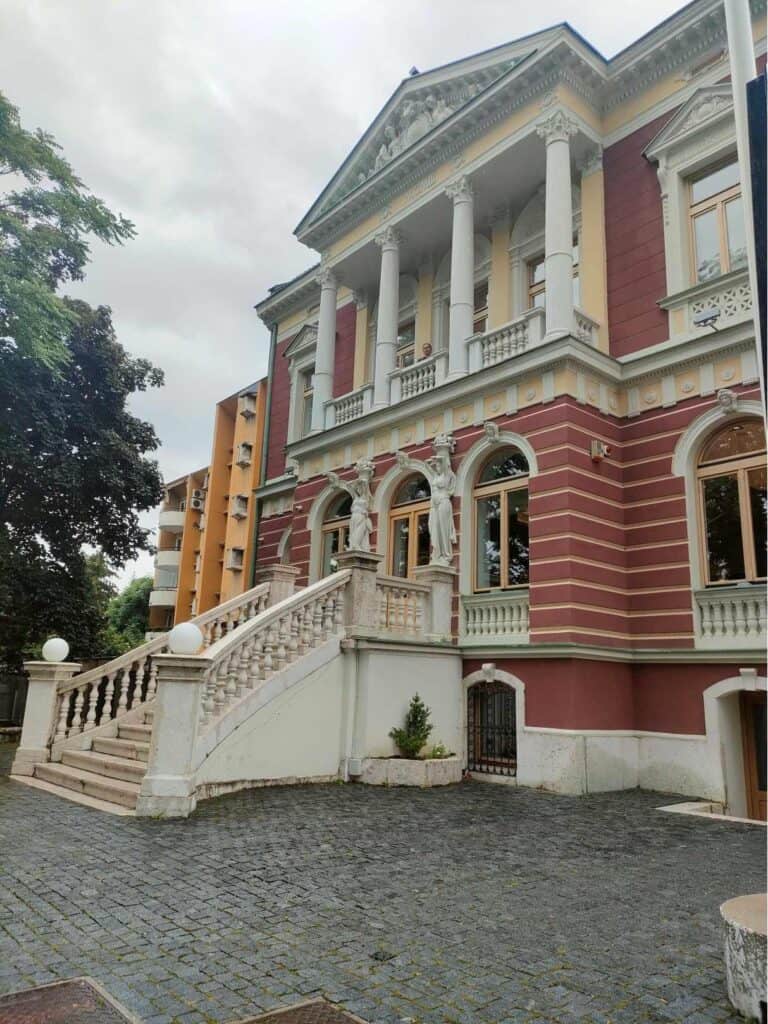
War Childhood Museum
In 2010, Sarajevo native Jasminko Halilovic started to collect memoirs from as many people as possible who were children during the Bosnian War. The War Childhood Museum is aimed at telling how it was to live under the siege of Sarajevo as a child. The objects on display each has a story. For example, a Lollipop that a child comments on in this way: “This is a lollipop that survived the war because it stayed hidden. Like any parent, my father hid candy from us children, and in wartime, he would sometimes surprise us with a piece. In 1994 he died on his way to work, and so this lollipop stayed “lost” among his things. We stumbled upon it when the war ended, and I decided to keep it.”
The story behind the books Endemic Plants and Latin Grammar from another child is:
“It was a winter morning. I was alone in my bedroom, lying on the couch. After the air-raid siren sounded. I heard my window glass shatter. I got very scared. When my mom entered the room, I turned and saw that the piece of shrapnel that tore through the window had lodged into the bookcase between the titles Endemic Plants and Latin Grammar.“
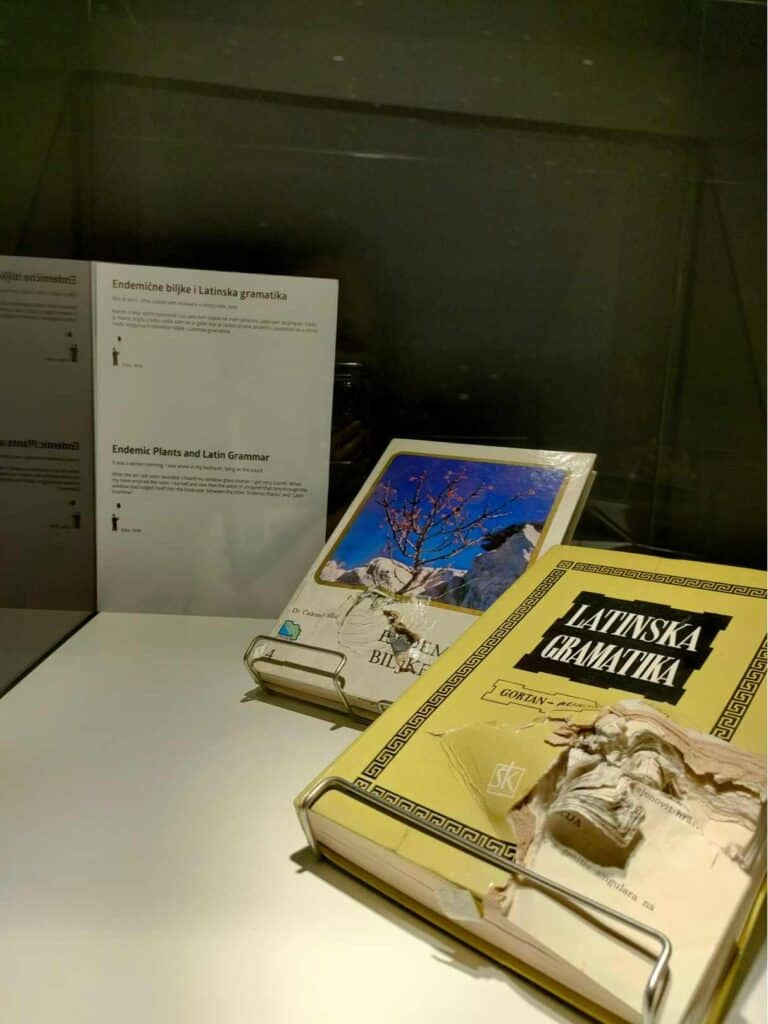
You can read similar stories in this highly emotional museum that will be extended with the stories of children from the war in Ukraine.
Opening hours:
Monday to Sunday: 11 am – 7 pm
Entrance fee: 10 KM (5 EUR)
The rich collection of the National Museum with archeological, ethnology, and natural history department and the Library is close to the iconic Holiday Inn hotel. The Sarajevo Haggadah, the handwritten 600-year-old Jewish manuscript on calfskin, is on display in a glass case reminding of the once thriving Jewish community in the city. It describes the crucial events of Jewish history, like the exodus from Egypt.
Best local tours in Sarajevo
Even if you travel alone, local tours are a great way to immerse in the local culture and learn more about its history. It is especially important in Sarajevo. The best way to learn about the war is to take a local tour led by people who lived during the war and until now in Sarajevo. Especially that the scars of war are still seen in many places in the city, and even after 28 years, it is still engraved in people’s mind. These tours get excellent reviews from travelers, which can be your visit’s highlight. They are available in English only, so I wrote the names of the tours in English as well so that you can find them. Some of them I took myself, and others I would have been interested in doing. It may be helpful for you. Some have a fixed price, while others are free, but you are expected to give a tip. I hope this is useful for your visit; save it for later!
– East meets West free Sarajevo walking tour by Neno and friends
passing by the most important sights of Sarajevo (Emperor’s Mosque, Orthodox Church, Sacred Heart Cathedral, Baščaršija, the City Hall, Inat Kuća, the footsteps of Gavrilo Prinzip, the “colorful building” among others. Apart from the attractions you will learn about life during the war and now.
Book the tour here
– War Scars and New Times free walking tour by Neno and friends
A war-themed walking tour about the “cultural revolution” during the war, “Sarajevo Roses,” Holiday Inn, Memorial to Children killed during the siege of Sarajevo, Parliament, bridge of the Rome and Juliet of Sarajevo and a lot more. It is a great tour led by Neno, who lived during the war and shares his personal experience while explaining what happened during the war.
Book the tour here
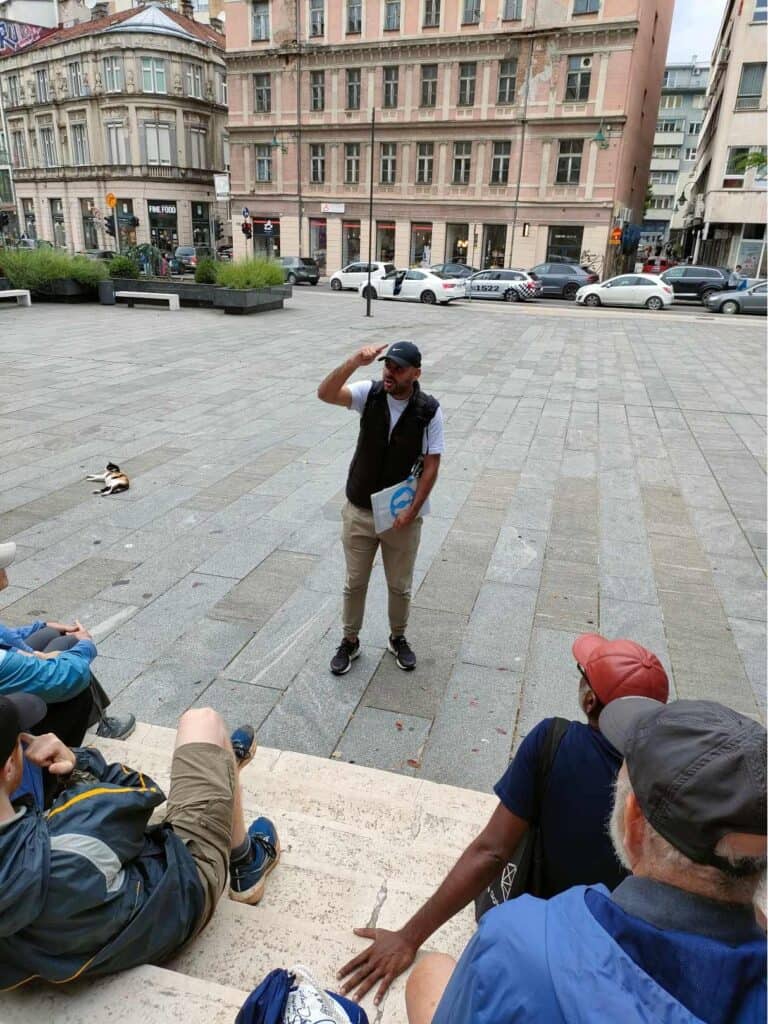
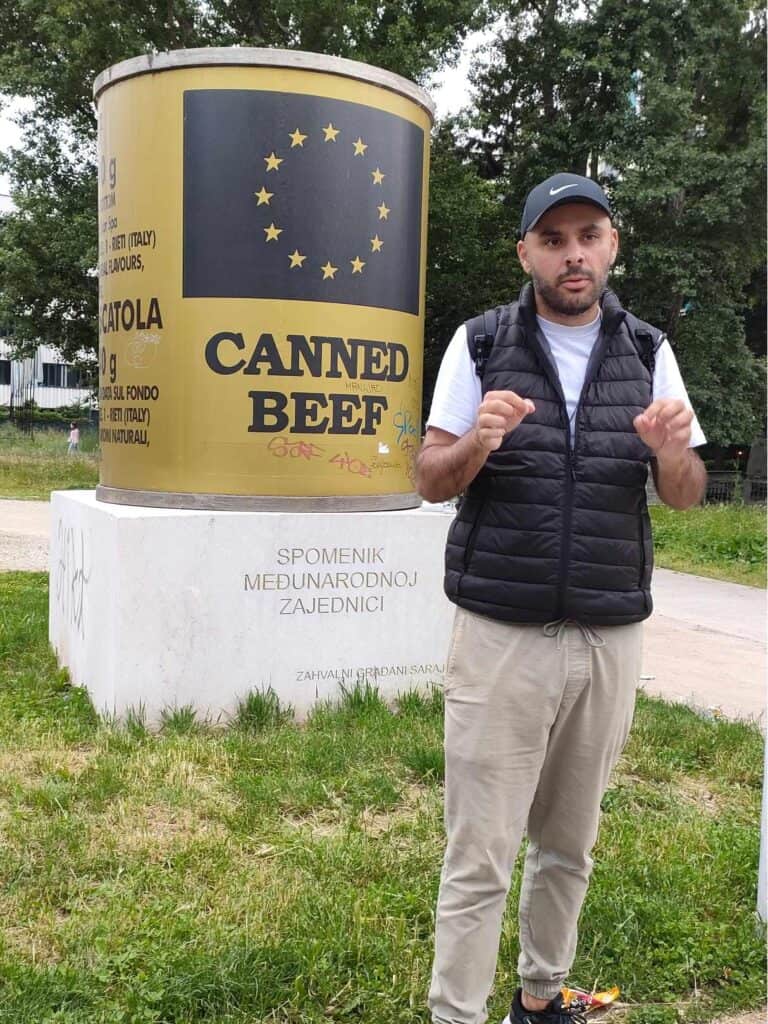
– Times of Misfortune tour by Sarajevo insider
This great tour combines many important places of Sarajevo: the Olympic Stadion, the view from the Yellow Fort, the Markale market, the “Sniper Alley” and Holiday Inn hotel, and the “Tunnel of Hope”.
Sarajevo Food & Craft tour by Meet Bosnia travel agency
This tour combines learning about traditional crafts in Sarajevo (coppersmith, a coffee shop where coffee grinders are still handmade, and paintbrush makers. At the same time, you will try local cheese, smoked meat, and sweet baklava, a fine introduction to the culinary traditions of Sarajevo.
Bosnian Cooking Class
Learn how to make Bosnian specialties with locals. Book your cooking class here.
Fall of Yugoslavia | Sarajevo Siege Tour (by Meet Bosnia)
Another tour about the war with excellent reviews, including a visit to the Tunnel of Hope with a focus on the story of Yugoslavia as well.
Olympic Tour in Sarajevo by Meet Bosnia
Visit the Olympic mountains, Olympic Museum, visit Olympic Stadion, Olympic village and jumping slopes
Full-day Sarajevo tour
There are so many great things to see and learn about in Sarajevo, so why not make a fully comprehensive tour starting with a 3 km horse carriage ride through rows of plane and chestnut trees in Big alley in Ilidza that connects this area with Bosna River Springs. Continue to discover Baščaršija, the Olympic sights, and the war tunnel.
Sarajevo War Tour: A Veteran’s Story of the Siege by Funky Tours
This war-themed tour is different in that it includes going up to Trebević mountain, where, apart from the Olympic bobsleigh track, you get an introduction to the frontline, where Bosnian Serbs were stationed. Bunkers, minefields, military tank caterpillar traces, tranches, bullets, grenade shrapnel, and many other destruction sites are still visible. You also go to Trebević Vidikovac, one of the most beautiful viewpoints above Sarajevo, the position of the Army of the Republic of Srpska.
Roses of Sarajevo + Tunnel of Hope
This tour includes the view of the Trebević Mountain and sniper zones, Romeo and Juliet’s bridge, the Jewish history, and Bascarsija.
A Glimpse of the war
City war scars tour (takes you to the most devastated residential part of Sarajevo in the outskirts and see everyday life outside the tourist part, all with public transport)
Check the tour here
Tandem Paragliding Experience in Sarajevo, Bosnia and Herzegovina
Book the paragliding adventure here
Best day trips from Sarajevo
A day trip to Srebrenica
Visit the Potočari memorial where the victims of the Srebrenica massacre of 11th July 1995 are buried. During the tour, you get an explanation about the worst atrocity that happened in Europe since the end of World War II, where you also meet a survivor.
Hiking to Lukomir
Visit the most isolated village in Europe, on a day trip from Sarajevo, including Bosnian lunch.
Day trip from Sarajevo to Mostar, Blagaj, and Počitelj
Mostar, the capital of Herzegovina geographical region, is the most beautiful city in the country thanks to the Old Bridge spanning over the Neretva and the surrounding Ottoman-style old town and was the most devastated city during the war. Apart from Mostar, the tour includes the picturesque Dervish monastery in Blagaj and Počitelj at the Neretva river and the Kravice waterfalls.
Travnik, Jajce, and Pliva lakes
Visit the former flourishing trade center, Travnik, with the iconic Coloured mosque, the waterfalls of Jajce, and the nearby Pliva lakes. It is a great day trip from Sarajevo to see the countryside and combine a cultural and nature trip.
Tito’s bunker in Konjic
Take a local tour to visit this unique place between Sarajevo and Mostar. The military bunker of Tito, the former president of Yugoslavia, was an engineering masterpiece and the largest secret base in Yugoslavia. It was built 280 meters below the mountain with all the facilities that allowed the communist elite to stay safe and dominate the country for months before a nuclear attack. A must-see when you travel around Bosnia and Herzegovina.
Višegrad, Andrićgrad, Šargan Train, Drvengrad Tour
The road to Višegrad leads through a stunning landscape along the Drina River. The small town has one of the most important historic sights of Bosnia and Herzegovina, the Mehmed Pasa Sokolovic Bridge, a UNESCO World Heritage Site. You also see Andrićgrad, the district built by Emir Kusturica filmmaker to honor the Nobel Prize-winning author Ivo Andric. On the Serbian side, visit the town of Drvengrad, a similar concept. This tour is excellent for getting to know the countryside and Republika Srpska.
Other posts about Bosnia and Herzegovina
Bosnia and Herzegovina travel guide and itinerary (3 days, 4 days and one week)
The 10 best day trips from Mostar
Mostar travel guide /How to spend one day in Mostar
I hope this travel guide helps you plan your perfect Sarajevo itinerary whether you have one, two or 3 days. As I mentioned above, I definitely recommend going on a local tour that can be the most memorable part of your trip. It is the best way to interact with locals and better understand the place regardless of whether you are interested in the war or the culinary aspects of the city.

